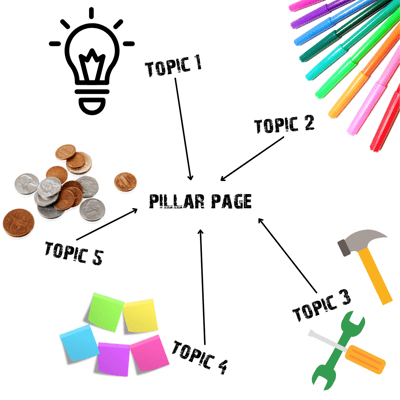The terms “pillar page” and “topic cluster” are often used together, but the concepts are quite different. A pillar page is a standalone page on your website that covers an overarching topic in-depth. A topic cluster, on the other hand, is a group of runners around a central topic that all support one another.
Many recommend creating at least one pillar page for each of your main website topics. But is this necessary? And if so, how do you go about creating a pillar page? In this article, we’ll discuss what a pillar page is and why you might need them for your website. We’ll also provide tips for creating an effective pillar page.
What Is a Pillar Page?
A pillar page is a comprehensive guide to a particular topic, covering all the necessary information on that topic in one place.
Pillar pages are usually around 2,000 to 3,000 words long and include a variety of subtopics. They are meant to be a resource for people who want to learn about a certain topic.
Pillar pages are different from other types of website pages, such as blog posts, in that they are much more comprehensive and cover a topic in-depth.
 What Is a Topic Cluster?
What Is a Topic Cluster?
A topic cluster is a group of pages on your website that are all related to a central topic. The pillar page is the centerpiece of the topic cluster and covers the main theme in-depth, while the other pages in the cluster support the pillar page by covering specific subtopics.
Topic clusters are effective because they help you rank for a variety of keywords related to your main topic. They are also helpful for website visitors because they provide a comprehensive guide to a particular topic.
How Long Should a Pillar Page Be?
As mentioned earlier, pillar pages are usually around 2,000 to 3,000 words long. This may seem long, but the length is necessary to effectively cover all the information on the topic.
If you try to make your pillar page too short, you’ll likely end up leaving out important information. On the other hand, if you make it too long, you risk losing your reader’s attention.
The best way to determine the ideal length for your pillar page is to look at similar pages on other websites. See how long they are and use that as a starting point for your page.
A technique for reaching this number is by using various on-page sections such as drop-down menus and FAQs.
How Can Pillar Pages Help With SEO?
Help You Rank for a Variety of Keywords
By including a variety of subtopics on your pillar page, you can target a wider range of keywords related to your main topic.
Build Authority for Your Website
Pillar pages partly determine your website’s authority. If bloggers, industry experts, or general users find your pillar pages comprehensive and informative, then they will likely view and even link to your website. When others accept your website as a credible source, your authority skyrockets!
Improve the User Experience
A pillar page is a web page that focuses on one specific topic and provides an in-depth guide to it. This is beneficial because it allows visitors to obtain all the information they require on a single page without having to click around.
Increase the Chances of Being Linked to Other Websites
Websites are more likely to link to your website if you have a pillar page. This is because pillar pages offer comprehensive and valuable information on a particular topic.
 Types of Pillar Pages
Types of Pillar Pages
There are four main types of pillar pages:
- How-To Pillar Pages
- Resource Pillar Pages
- Comparison Pillar Pages
- List Pillar Pages
How-To Pillar Pages
As the name suggests, how-to pillar pages provide step-by-step instructions on how to do something. They are usually formatted as a list of steps that the reader can follow.
Resource Pillar Pages
Resource pillar pages are a type of how-to page, but instead of providing steps on how to do something, they offer a list of resources that the reader can use.
Comparison Pillar Pages
Comparison pillar pages provide an in-depth comparison of two or more products, services, or concepts. They are helpful for readers who want to know the differences between two things.
List Pillar Pages
List pillar pages are similar to resource pillar pages in that they offer a list of information. However, instead of listing resources, they list things such as tips, tricks, or ideas.
Conclusion
Pillar pages are important pieces of your website’s design and content. They are comprehensive and in-depth guides to particular topics that can help with SEO by ranking for related keywords, building authority, and improving the user experience. There are four main types of pillar pages: how-to pages, resource pages, comparison pages, and list pages. If you’re looking to create more effective website content, consider using a pillar page as your starting point.
Our team at Connection Model can help you create SEO-friendly content for your website. We specialize in SEO services and can help you develop a comprehensive content strategy that will improve your website’s visibility and authority. Contact us today to learn more about our services!
Written By: David Carpenter


